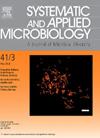一种来自高盐湖的极度嗜盐自养型甲基营养菌
IF 4.2
2区 生物学
Q2 BIOTECHNOLOGY & APPLIED MICROBIOLOGY
引用次数: 0
摘要
到目前为止,还没有报道三甲胺(TMA)-利用极端嗜盐微生物在高盐栖息地。我们在西伯利亚西南部的高盐苏打(pH值为9.5)或硫酸盐氯化物(pH值为7)湖泊的表层沉积物中接种了5 mM TMA,总Na+浓度为4 M的好氧富集,仅对后者成功。最初的富集包括细菌和盐古菌,但只有细菌成分能够作为TMA的纯培养物生长。菌株Cl-TMA在Thiohalorhabdus属中形成了一个新种谱系,其中包括极端嗜盐性和专性自养硫氧化γ变形菌。Cl-TMA可以利用TMA、二甲胺(DMA)和甲醇(MeOH)作为电子供体进行甲基自养生长,也可以利用硫代硫酸盐进行化能自养生长。三种甲基化合物和硫代硫酸盐也观察到混合营养生长。碳通过Calvin-Benson-Basham途径自养同化。与反硝化Thiohalorhabdus的模式物种不同,Cl-TMA不能通过反硝化进行厌氧生长。该分离物属于生长在2.5 ~ 5 M NaCl范围内的极端嗜盐菌,最佳生长条件为3 ~ 3.5 M NaCl。基因组分析鉴定出两个基因簇编码pqq依赖性甲醇脱氢酶(MxaFI和XoxF),四个甲醛激活酶(Faes)同源物,一个TMA/DMA氧化位点,以及两个编码甲胺氧化n -甲基谷氨酸脱氢酶途径(NMGP)的基因簇。c1 -底物转化的第一步是四氢叶酸(THF)连接和四氢甲烷蝶呤(H4MPT)连接的甲醛氧化途径和两种甲酸脱氢酶。所有这些甲基化特征在反硝化弓形虫中都不存在。相比之下,在模式物种中存在的两个关键硫氧化酶,硫代硫酸盐脱氢酶TsdAB和硫代硫酸盐脱氢酶FccAB的基因在Cl-TMA中缺失。硫代硫酸盐通过不完全Sox循环和sHdr系统的结合被氧化为硫酸盐。菌株Cl-TMAT (JCM 35977 = UQM 41915)拟归类为Thiohalorhabdus methylotrophus sp. nov。本文章由计算机程序翻译,如有差异,请以英文原文为准。
Thiohalorhabdus methylotropha sp. nov., an extremely halophilic autotrophic methylotiotroph from hypersaline lakes
So far, there have been no reports of trimethylamine (TMA)-utilizing extremely halophilic microorganisms in hypersaline habitats. Our aerobic enrichments at 4 M total Na+ with 5 mM TMA inoculated with surface sediments from hypersaline soda (at pH 9.5) or chloride-sulfate (at pH 7) lakes in southwestern Siberia were successful only for the latter. The initial enrichment included both bacteria and haloarchaea but only the bacterial component was able to grow as a pure culture with TMA. Strain Cl-TMA forms a new-species lineage within the genus Thiohalorhabdus which includes extremely halophilic and obligate lithoautotrophic sulfur-oxidizing gammaproteobacteria. Cl-TMA can grow methyloautotrophically utilizing TMA, dimethylamine (DMA) and methanol (MeOH) as the electron donors or chemolithoautotrophically with thiosulfate. Mixotrophic growth was also observed with the three methyl compounds and thiosulfate. Carbon is assimilated autotrophically via the Calvin-Benson-Basham pathway. Unlike the type species of Thiohalorhabdus, T. denitrificans, Cl-TMA was incapable of anaerobic growth via denitrification. The isolate belongs to extreme halophiles growing between 2.5 and 5 M NaCl with an optimum at 3–3.5 M. Genome analysis identified two gene clusters coding for PQQ-dependent methanol dehydrogenases (MxaFI and XoxF), four homologues of the formaldehyde activating enzymes (Faes), a TMA/DMA oxidation locus, and two cluster of genes encoding an N-methylglutamate dehydrogenase pathway (NMGP) for methylamine oxidation. The first steps of C1-subtrate conversions are followed by the tetrahydrofolate (THF)-linked and tetrahydromethanopterin (H4MPT)-linked formaldehyde oxidation pathways and two formate dehydrogenases. All of those signatures of methylotrophy were absent in T. denitrificans. In contrast, genes for two key sulfur oxidation enzymes, thiosulfate dehydrogenase TsdAB and sulfide dehydrogenase FccAB, that are present in the type species are missing in Cl-TMA. Thiosulfate is oxidized to sulfate by a combination of an incomplete Sox cycle and an sHdr system. Strain Cl-TMAT (JCM 35977 = UQM 41915) is proposed to be classified as Thiohalorhabdus methylotrophus sp. nov.
求助全文
通过发布文献求助,成功后即可免费获取论文全文。
去求助
来源期刊

Systematic and applied microbiology
生物-生物工程与应用微生物
CiteScore
7.50
自引率
5.90%
发文量
57
审稿时长
22 days
期刊介绍:
Systematic and Applied Microbiology deals with various aspects of microbial diversity and systematics of prokaryotes. It focuses on Bacteria and Archaea; eukaryotic microorganisms will only be considered in rare cases. The journal perceives a broad understanding of microbial diversity and encourages the submission of manuscripts from the following branches of microbiology:
 求助内容:
求助内容: 应助结果提醒方式:
应助结果提醒方式:


